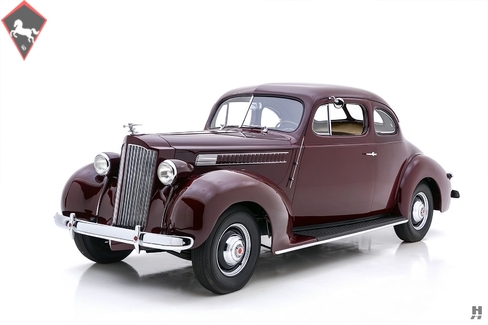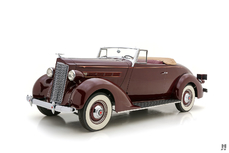Packard Six (1937-49) Coupe 1939
General description :
By the late 1930s, it was finally clear to Packard’s board of directors that a mid-priced model was essential to the survival of the company. Unlike many of their competitors, Packard weathered the Great Depression relatively well, emerging bruised and battered, yet still standing. After one failed attempt at tackling the mid-price market with the 900 “Shovelnose” in 1932, Packard finally got serious with the eight-cylinder One-Twenty of 1935. But unlike the 900, the One-Twenty proved to be a runaway success. By 1937, a smaller, six-cylinder model joined the One-Twenty in the Junior line. It was the first six-cylinder automobile produced by Packard since 1927, utilizing what was, in essence, a One-Twenty engine minus two cylinders, in a similar chassis albeit with a shorter wheelbase. The six was still quite powerful, allowing for 100 mph performance in an efficient and cost-effective, and highly competitive package. For its debut year, the six-cylinder model was named the 115C, referencing its 115-inch wheelbase chassis.
Aimed squarely at Hudson, Oldsmobile, and Pontiac, the 115-C or simply “Packard Six,” was an instant sales hit, selling more than 65,000 units in its first year alone. Thanks to the six, thousands of middle-class Americans could now live the previously unattainable dream of owning a brand new Packard automobile. 1938 saw the introduction of a lengthened chassis and heavily revised sheet metal that contributed to a more balanced style, and sales continued at an impressive clip. For the 1939 model year, or Seventeenth Series in Packard parlance, much of the previous car carried over, with the most notable addition being the so-called “Handi-Shift” column-mounted gear change. The 245 cubic-inch inline-six produced an even 100 horsepower and 195lb/ft of torque. The chassis featured independent front suspension, with powerful hydraulic brakes and the robust, quality engineering that Packard buyers of all levels came to expect. Coachwork options for the Six included two coupes, two sedans, a convertible coupe, and a station wagon. Thanks to the outstanding value and quality offered by the Junior line, Packard enjoyed one of the most prosperous periods in the history of the firm.
Officially known as a Model 1700-1285, this 1939 Packard Six wears attractive two/four- passenger Club Coupe bodywork. This outstanding example of Packard’s mid-market sales leader wears a superb restoration that has seen occasional use and regular maintenance as part of a significant collection of collector automobiles. It presents in a beautiful shade of deep maroon over a taupe fabric interior, with a clean, period-correct look. Paintwork is excellent, exhibiting straight reflections in the bodywork and excellent panel fit. The brightwork is in fine order all around, with beautiful re-chromed bumpers, correctly detailed hub caps, a Goddess of Speed mascot, and of course, the proud Packard radiator grille.
The interior is a particular highlight, with the four-passenger cabin trimmed in lovely taupe twill fabric on the doors panels, front seats, and rear jump seats. The carpet and broadcloth headlining are similarly outstanding and finished to a high standard. The driver faces the original steering wheel with optional Handi-Shift column-mounted gear lever. The restored instruments sit in a stunning woodgrain-effect steel dash panel with period-correct switches and controls. Similar attention to detail was paid to the trunk upholstery, which is very well detailed.
Under the center-hinged hood sits Packard’s bulletproof 245 cubic-inch six-cylinder. Based on the legendary L-head eight design, the six offers similar levels of refinement with little sacrifice in performance. Beneath the original oil-bath air cleaner is a factory-correct Carter WA-1 downdraft carburetor. Under-hood detailing is authentic with proper wire-type hose clamps and labels and markings where appropriate. While very clean under the hood, there are some signs of regular use, with slight dulling of the painted engine block and evidence of heat cycles on some surfaces. The undercarriage is similarly presented, impressively clean and tidy while displaying evidence of enjoyment on the road.
Rarely do we encounter Packard Sixes of this era quite so nicely restored. This marvelous car benefits from recent expert care, and it would make a superb companion for casual touring and road events and is sure to satisfy any aficionado of late pre-war American classic automobiles.
Offers welcome and trades considered
https://hymanltd.com/vehicles/6551
1939 Packard Six (1937-49) Coupe is listed sold on ClassicDigest in St. Louis by Mark Hyman for $44950.
Car Facts
Car type : Car Make : Packard Model : Six (1937-49) Model Version : Coupe Engine size : 0.0 Model Year : 1939 Sub type : Coupé Location : Missouri
Sold
Seller Information
Sold
People who viewed this Packard Six (1937-49) also viewed similar Packard listed at ClassicDigest
Other cars listed for sale by this dealer
About Packard
Packard: A Comprehensive HistoryEarly Years and Foundation:
Founding: The Packard Motor Car Company was established in 1899 in Warren, Ohio, by James Ward Packard, William Doud Packard, and George Lewis Weiss.
Pioneering Luxury: Initially producing high-quality automobiles, Packard became synonymous with luxury, craftsmanship, and engineering excellence.
Notable Achievements and Contributions:
Packard Twin Six: Introduced in 1916, this V12-powered car established Packard as a premier luxury automobile brand.
Model Line Expansion: Packard expanded its lineup with various models, including sedans, coupes, convertibles, and limousines, catering to affluent customers seeking elegance and performance.
Engineering Innovations: The brand introduced several innovations, such as the first use of aluminum pistons, air conditioning, and the Ultramatic automatic transmission.
Ten Historically Significant Models with Technical Specifications:
Packard Twin Six (1916):
Engine: 7.3L V12 engine.
Performance: Around 85 horsepower.
Packard Eight (1930-1938):
Engine: Straight-8 engine with various displacements.
Performance: Ranged from 90 to over 130 horsepower.
Packard Super Eight (1939-1951):
Engine: Straight-8 engine.
Performance: Produced between 130 to 180 horsepower.
Packard One-Twenty (1935-1942):
Engine: Straight-8 engine.
Performance: Approximately 100 to 120 horsepower.
Packard Clipper (1941-1957):
Engine: V8 engine.
Performance: Ranging from 135 to 185 horsepower.
Packard Caribbean (1953-1956):
Engine: V8 engine.
Performance: Varying between 275 to 310 horsepower.
Packard Patrician (1951-1956):
Engine: Inline-8 and V8 engines.
Performance: Ranged from 150 to 180 horsepower.
Packard Hawk (1958):
Engine: V8 engine.
Performance: Produced around 275 horsepower.
Packard Executive (1956-1958):
Engine: V8 engine.
Performance: Varying between 240 to 290 horsepower.
Packard Predictor (1956):
Engine: Concept car showcasing design and technology.
Performance: Prototype model.
Legacy and Influence:
Quality and Elegance: Packard was revered for its exceptional build quality, refined styling, and luxury features, often considered on par with European luxury brands like Mercedes-Benz.
End of Production: The brand faced financial struggles in the 1950s, leading to its merger with Studebaker and eventual discontinuation in the late 1950s, marking the end of an era in American luxury automobiles.
Packard left an enduring legacy in the automotive industry, symbolizing elegance, engineering excellence, and a commitment to luxury that has been admired and respected by car enthusiasts worldwide.







